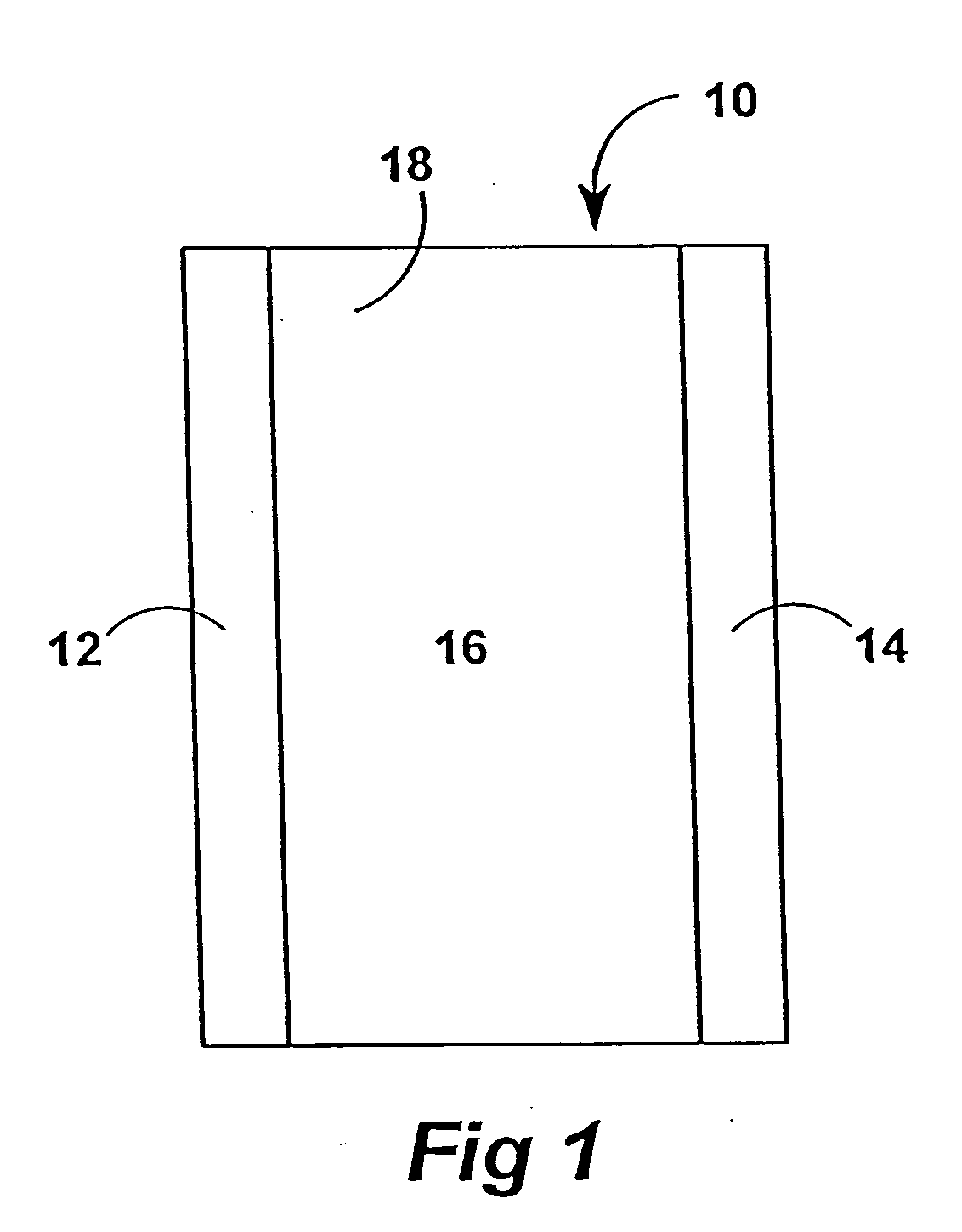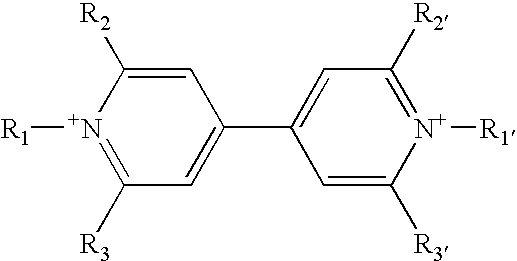Electrochromic salts, solutions, and devices
a technology of electrolyte solution and electrolyte, applied in the direction of discharge tube luminescnet screen, non-aqueous electrolyte cells, instruments, etc., can solve the problems of limited solubility of molten salts, /sup> may be unstable, limited commercial electrochromic windows and mirrors,
- Summary
- Abstract
- Description
- Claims
- Application Information
AI Technical Summary
Problems solved by technology
Method used
Image
Examples
example 1
[0167] Preparation of 1,1′-dimethyl-4,4′-dipyridinium bis(bis(trifluoromethylsulfonyl)imide) [15]. A first solution of 1,1′-dimethyl-4,4′-dipyridinium dichoride (1.128 g in 10 mL distilled H2O) was prepared. A second solution of lithium bis(trifluoromethylsulfonyl)imide (LiNTf2) (1.264 g in 10 mL distilled H2O) was prepared and slowly added via pipette to the first solution with stirring. Salt 15 formed as a white solid. The mixture was filtered, and the solid white powder MeV(NTf)2 formed. The solution was filtered and the solid was dissolved in acetone. The acetone was removed under a vacuum to produce 15 as a white powder.
example 2
[0168] Preparation of a solution of the radical cation of [15]. An electrolyte solution of about 0.011 g of 15 (prepared according to Example 1) in about 1.0 mL 1-butyl-3-methylimidazolium bis(trifluoromethylsulfonyl)imide was prepared under an inert atmosphere of helium. A chamber for the solution was provided by compressing a 0.5 inch diameter o-ring in between two 0.5-inch diameter conducting indium tin oxide (ITO) electrodes. The electrolyte solution was injected into the chamber through the o-ring.
[0169] The electrodes were connected to an HCH instruments Model 730A Electrochemical Analyzer. Bulk electrolysis of the solution at the reducing potential of −0.5V, which was indicated by the first peak of the cathodic wave, produced a blue color for the solution within about 5 seconds.
example 3
[0170] Preparation of an electrochromic window using [15]. An electrolyte solution of about 0.022 g of 15 and about 0.0050 g N,N,N,N-tetramethyl-p-phenylenediamine in about 2.0 mL 1-butyl-3-methylimidazolium bis(trifluoromethylsulfonyl)imide was prepared under an inert atmosphere of helium. A chamber for the solution was provided by compressing a 0.5 inch diameter o-ring in between two 0.5-inch diameter conducting indium tin oxide (ITO) electrodes. The solution was injected into the chamber through the o-ring to provide an electrochromic window.
[0171] The electrodes of the window were connected to an HCH instruments Model 730A Electrochemical Analyzer. Bulk electrolysis of the solution at the reducing potential of −0.5V (indicated by the first peak of the cathodic wave) produced a blue color within about 5 seconds.
PUM
| Property | Measurement | Unit |
|---|---|---|
| glass transition temperatures | aaaaa | aaaaa |
| glass transition temperatures | aaaaa | aaaaa |
| melting points | aaaaa | aaaaa |
Abstract
Description
Claims
Application Information
 Login to View More
Login to View More - R&D
- Intellectual Property
- Life Sciences
- Materials
- Tech Scout
- Unparalleled Data Quality
- Higher Quality Content
- 60% Fewer Hallucinations
Browse by: Latest US Patents, China's latest patents, Technical Efficacy Thesaurus, Application Domain, Technology Topic, Popular Technical Reports.
© 2025 PatSnap. All rights reserved.Legal|Privacy policy|Modern Slavery Act Transparency Statement|Sitemap|About US| Contact US: help@patsnap.com



